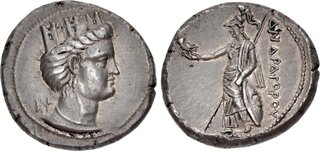| Classical Numismatic Group > Triton XXVII | Auction date: 9 January 2024 |
| Lot number: 325 Price realized: 4,250 USD (Approx. 3,893 EUR) Note: Prices do not include buyer's fees. | Show similar lots on CoinArchives Find similar lots in upcoming auctions on |
| Lot description: SELEUKID EMPIRE. Andragoras. Seleukid governor, circa 280-275 BC. AR Tetradrachm (26.5mm, 17.06 g, 6h). Turreted head of Tyche right, wearing single-pendant earring and linear necklace; monogram to left / Athena, wearing crested Corinthian helmet and chiton, standing left, holding owl in extended right hand and resting arm on shield set on ground below to right; transverse spear in background, ANΔPAΓOPOY to right. SC –; Kritt, Andragoras 34 (A9/P15 – this coin, illustrated); Taylor, Birds, Series 6.2, 223 var. (unlisted dies); MIG Type 20; HGC 9, –; BMC Arabia p. 193, 4. Toned, with faint iridescence around the devices, trace deposits, struck with worn obverse die. EF. Rare. The identification of Andragoras has been a matter of debate. Justin mentions two people by that name: (1) a noble Persian appointed by Alexander the Great as governor of Parthia (xii.4.12), and (2) a Seleukid governor of Parthia about the middle of the 3rd century who was defeated by Arsakes (xli.4.7). Both extremely rare gold staters and scarce silver tetradrachms are known in his name, neither of which bear the royal title Basileos. What literary evidence exists derives from the later Greco-Roman historians of Alexander (Arrian and Curtius), as well as the first century AD historian, Pompeius Trogus (known later through Justin). One possible contemporary piece of evidence – a Greek inscription from Gurgan – mentions Andragoras as a high official under Antiochos I (see J. Wolski, "Andragoras était-il Iranien ou Grec?" Studia Iranica 4 [1975], pp. 166-69). B. Kritt, in his recent work, Andragoras, Double Darics, and the coinage of Alexandria on the Oxus (Lancaster, PA: Classical Numismatic Group, 2022), reassessed the totality of the evidence, and persuasively argues that the coinage was struck earlier than previously thought, circa 280-275 BC, rather than circa 249-239/8 BC. As such, our Andragoras must be the one mentioned in the Gorgan inscription (SEG 20.325), which is dated to the time of Antiochos I. Andragoras could not have been the later satrap of Parthia. In fact, he was the governor of Alexandreia on the Oxus, appointed by Antiochos I shortly after his accession to the throne, circa 280 BC. Andragoras, who was in his late sixties when appointed, ruled over the Seleukid colony until his death, circa 275 BC. Estimate: 3000 USD |  |



